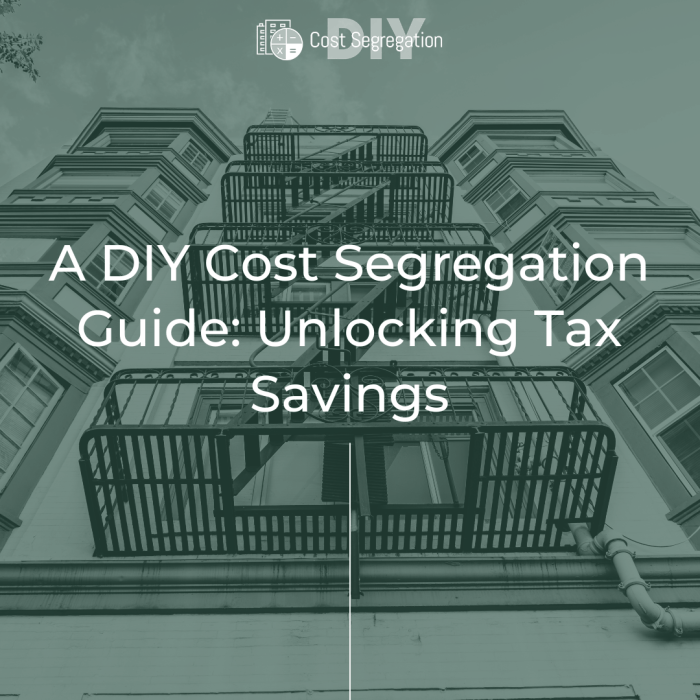DIY Cost Segregation sets the stage for a compelling journey into the world of tax optimization, allowing businesses to maximize their deductions and minimize their tax liabilities. This guide provides a comprehensive understanding of the process, empowering you to take control of your financial future.
Cost segregation is a powerful tool that allows businesses to reclassify their assets, separating long-lived assets into shorter-lived components. This reclassification can result in significant tax savings through accelerated depreciation. By performing cost segregation independently, you can gain valuable insights into your assets and take advantage of these tax benefits.
Introduction to DIY Cost Segregation

Cost segregation is a tax-saving strategy that allows businesses to reclassify certain expenses from long-term assets to shorter-term assets. This reclassification results in accelerated depreciation deductions, leading to significant tax savings.
DIY cost segregation refers to performing this analysis and reclassification process independently, without hiring a professional cost segregation specialist. While professional assistance is often recommended, there are advantages to performing cost segregation on your own.
Benefits of DIY Cost Segregation
Performing cost segregation independently can offer several benefits, including:
- Cost Savings: The most obvious benefit is cost savings. By performing the analysis yourself, you eliminate the fees associated with hiring a specialist. This can be a significant financial advantage, especially for smaller businesses with limited budgets.
- Greater Control: DIY cost segregation gives you complete control over the process. You can choose the specific assets to analyze and the level of detail you want to include. This allows you to tailor the analysis to your specific needs and priorities.
- Improved Understanding: Performing cost segregation yourself provides a deeper understanding of your assets and the depreciation process. This knowledge can be valuable for making informed decisions about your business’s future investments and tax planning.
“DIY cost segregation can be a cost-effective and efficient way to maximize tax savings, especially for businesses with a good understanding of their assets and depreciation rules.”
Cost Segregation Methods

Cost segregation is the process of identifying and separating the costs of a building into its various components. This allows you to depreciate each component over its useful life, which can result in significant tax savings. There are several methods that can be used to determine the cost of assets. The most common methods are discussed below.
Cost Segregation Methods, Diy cost segregation
The cost segregation methods are categorized into two main groups:
- Traditional Methods: These methods are based on historical data and industry standards. They are often used for smaller projects or when detailed cost information is not available. Examples include:
- Engineering Method: This method involves a detailed analysis of the building’s construction plans and specifications. An engineer will use this information to estimate the cost of each component. This method is accurate but can be time-consuming and expensive.
- Depreciated Cost Method: This method uses the depreciated cost of similar assets to estimate the cost of the current asset. This method is simple but may not be accurate if the asset is significantly different from similar assets.
- Unit-in-Place Method: This method uses a unit cost per square foot or other unit of measure to estimate the cost of each component. This method is quick and easy but may not be accurate for complex buildings.
- Modern Methods: These methods use advanced techniques such as computer modeling and data analysis to estimate the cost of assets. These methods are more accurate than traditional methods and can be used for larger projects. Examples include:
- Building Information Modeling (BIM): This method uses 3D models of the building to estimate the cost of each component. BIM is a highly accurate method but can be expensive.
- Artificial Intelligence (AI): AI-powered cost segregation software can analyze large datasets of building information to estimate the cost of assets. This method is becoming increasingly popular due to its speed and accuracy.
- Data Analytics: This method uses statistical techniques to analyze historical cost data and predict the cost of assets. This method is effective for large projects with a significant amount of historical data.
Advantages and Disadvantages of Cost Segregation Methods
Each cost segregation method has its own advantages and disadvantages.
- Traditional Methods:
- Advantages: These methods are generally less expensive than modern methods and can be used for smaller projects.
- Disadvantages: These methods may not be as accurate as modern methods and can be time-consuming.
- Modern Methods:
- Advantages: These methods are generally more accurate than traditional methods and can be used for larger projects.
- Disadvantages: These methods can be expensive and may require specialized expertise.
Examples of Cost Segregation Methods in Practice
- Engineering Method: A company is building a new manufacturing facility. The company hires an engineer to analyze the construction plans and specifications. The engineer estimates the cost of each component, such as the foundation, walls, roof, and HVAC system. This information is then used to determine the depreciable life of each component and calculate the tax savings.
- BIM Method: A real estate developer is constructing a new office building. The developer uses BIM software to create a 3D model of the building. The software then estimates the cost of each component, such as the structural steel, windows, and interior finishes. This information is used to determine the depreciable life of each component and calculate the tax savings.
- Data Analytics Method: A large retail chain is expanding its operations. The company uses data analytics to analyze historical cost data for similar retail stores. The data analysis predicts the cost of each component, such as the fixtures, shelving, and lighting. This information is used to determine the depreciable life of each component and calculate the tax savings.
Embarking on the DIY cost segregation journey empowers you to become a savvy tax strategist. By understanding the intricacies of the process, identifying eligible assets, and utilizing available tools and resources, you can unlock substantial tax savings. While challenges may arise, the potential benefits far outweigh the effort. Remember, careful planning, accurate documentation, and a thorough understanding of the process are crucial for success.
DIY cost segregation can be a valuable tool for businesses, helping them maximize tax savings by identifying and classifying assets. While it can be a complex process, there are many resources available to guide you through it. Just like crafting a DIY Barbie in a box costume requires careful planning and execution, DIY cost segregation needs a systematic approach to achieve optimal results.
By breaking down assets into their individual components, you can potentially unlock significant tax benefits, making it a worthwhile endeavor for any business owner looking to streamline their financial strategies.
